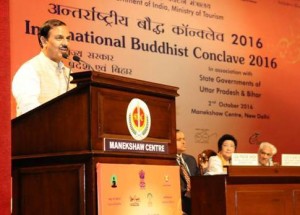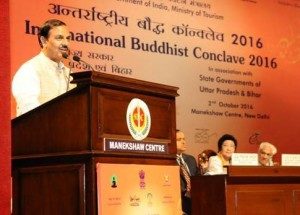Union Tourism and Culture Minister Mahesh Sharma inaugurated the 5th International Buddhist Conclave in Varanasi-Sarnath.
About International Buddhist Conclave :
With a view to showcase and project the Buddhist heritage and pilgrim sites of India, the Ministry of Tourism is organising the ”5th International Buddhist Conclave” (from October 2 to 6) in collaboration with the State Governments of Uttar Pradesh and Bihar.
- Tourism Ministry is organizing the fifth edition of the conclave with a view to showcase Buddhist heritage and pilgrimage sites in the country to attract tourists from overseas country.
- Over 285 participants from 39 counties are participating in the fifth edition of the event.
- Prime Minister Narendra Modi accords very high priority to Buddhism and which is reflected in record number – over 275 participants from 39 countries and the Tourism Ministry has sanctioned huge amount of money for development of Buddhist circuit.
- 2016 International Buddhist Conclave is very special as ASEAN is a Guest of Honor partner and a large participation is expected from ASEAN Countries which are also major source markets for India in general and the Buddhist Heritage sites in particular.
- The Conclave would include presentations, panel discussions, business-to-business meetings between domestic and international tour operators and state governments.
- Indian government has sanctioned about Rs 300 crore for development of Bhuddhist circuit which includes Rs 94 for construction of a cultural centre at Bodhgaya in Bihar.
- It is noted that India, the birthplace of Buddhism, has a very rich Buddhist Heritage with several important sites associated with the life ofBuddha which are essential pilgrimage centres for followers of the religion the world over.
About Buddhism :
- Buddhism is a religion and dharma that encompasses a variety of traditions, beliefs and spiritual practices largely based on teachings attributed to the Buddha.

Buddhism originated in India, from where it spread through much of Asia, where after it declined in India during the middle ages. Two major extant branches of Buddhism are generally recognized by scholars:
- Theravada (Pali: “The School of the Elders”) and
- Mahayana (Sanskrit: “The Great Vehicle”).
Buddhism is the world’s fourth-largest religion, with over 500 million followers or 7% of the global population, known as Buddhists.
- Buddhist schools vary on the exact nature of the path to liberation, the importance and canonicity of various teachings and scriptures, and especially their respective practices. Practices of Buddhism include Refuge, Samatha, Vipassanā, the Mahayana practice of Bodhicitta and the Vajrayana practices of Generation stage and Completion stage.
- In Theravada the ultimate goal is the attainment of the sublime state of nirvana, achieved by practicing the Noble Eight fold Path (also known as the Middle Way), thus escaping what is seen as a cycle of suffering and rebirth. Theravada has a widespread following in Sri Lanka and Southeast Asia






